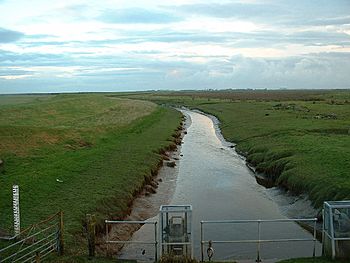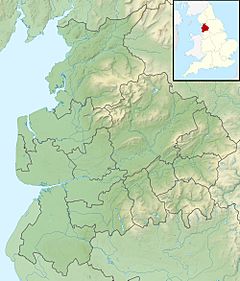River Cocker, Lancashire facts for kids
Quick facts for kids River Cocker |
|
|---|---|

River Cocker
|
|
|
Location of the mouth in Lancashire
|
|
| Country | United Kingdom |
| Constituent country | England |
| County | Lancashire |
| Physical characteristics | |
| River mouth | Lune estuary 53°57′59″N 2°51′25″W / 53.96639°N 2.85694°W |
The River Cocker is a small but important river located in Lancashire, England. It flows for about 17.5 kilometers (10.9 miles) before joining the larger Lune estuary. This river is known for its interesting wildlife and its connection to local history.
Contents
Where Does the River Cocker Start and End?
The River Cocker begins its journey near Yeat House Farm and Higher Knowe Hill. This area is south of Quernmore, close to the city of Lancaster.
The River's Path Through Lancashire
From its source, the river flows mostly southwest. It passes through pretty woodlands like Cocker Clough Wood and Brunstow Wood. It then goes by a place called Hampson Green.
The river briefly turns northwest when another stream, Potters Brook, joins it. This happens near the small village of Potters Brook. Here, the river even goes under the M6 motorway and the Lancaster Canal through special channels.
The River Cocker then curves south around the village of Cockerham. It passes Little Crimbles and gets bigger as Park Lane Brook and Lee Brook flow into it. Finally, the river reaches the saltflats below Cockersand Abbey. Here, it empties into the Lune estuary, which is where the Lune River meets the sea.
What Does the Name "Cocker" Mean?
The name "Cocker" has a cool history! It comes from an old word that refers to someone who raises, hunts, or fights with game birds. Think of birds like partridge.
This name fits well because the area around the River Cocker has a long history of farming poultry. You can still find many partridges and other game birds in the surrounding countryside today.
Wildlife Along the River Cocker
The area around the River Cocker is a special place for wildlife. Cockerham Marsh, near the river's mouth, is a designated SSSI. This means it's protected because of its important natural features.
Birds of the Cocker Estuary
The Cocker Estuary is a very important spot for birds, especially in winter. Thousands of pink-footed geese come here to spend the colder months. Sometimes, you can see flocks of over a thousand geese!
Many other seabirds also visit in winter, including:
- Oystercatchers
- Turnstones
- Grey plovers
- Red knots (often just called knot)
- Curlews
- Common redshanks
- Dunlins
In the summer, the estuary is home to many ringed plovers, which are also a wonderful sight.
How Clean is the River Cocker's Water?
The River Cocker is part of a larger area managed by the Environment Agency. This area includes the nearby River Conder.
Efforts to Improve Water Quality
The land around the river is mostly used for farming, with lots of cattle, sheep, and chickens. Because of this, pollution from farms has been a challenge for the river's water quality. Experts are working to make the water even better.
United Utilities, a water company, has provided money for a project called the "Cocker and Conder Clean Up." Recent reports show that the river's water quality is "Moderate" for things like ammonia and phosphates (which can come from farms). However, it's rated "Good" for chemical contamination, which is great news!


